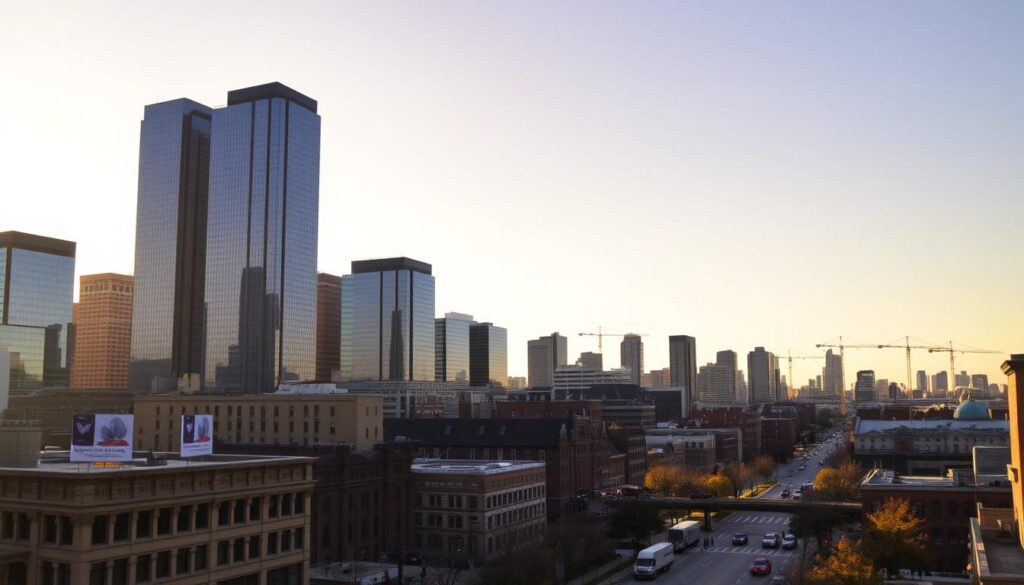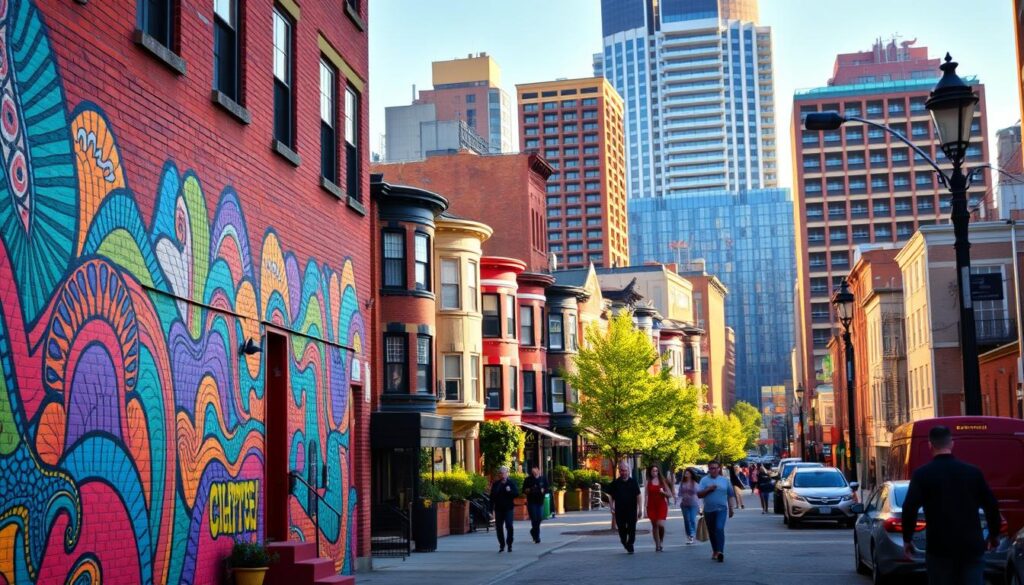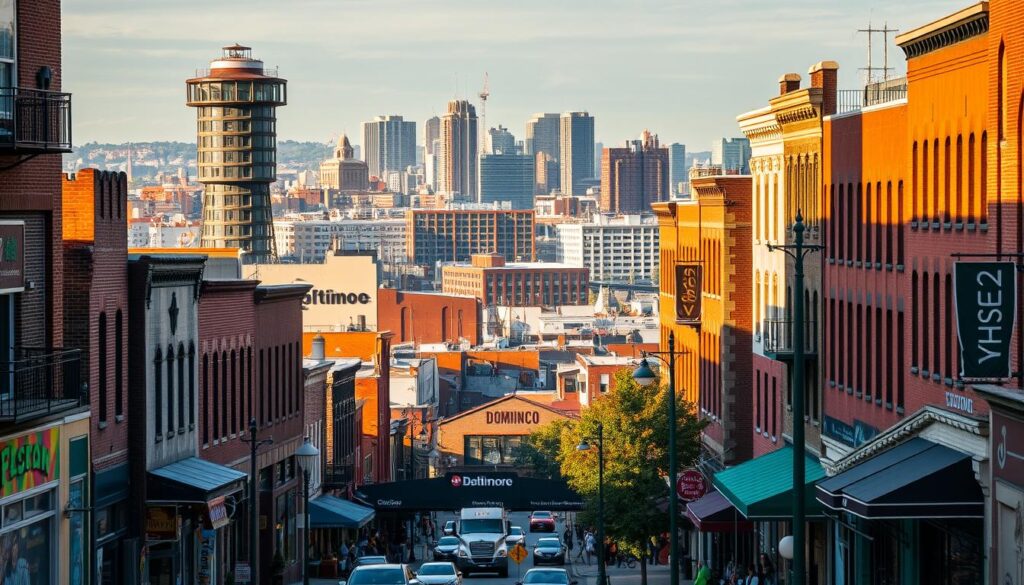Baltimore: Uncovering the City's Evolving Landscape

Baltimore is changing fast, with a rich history and diverse culture at its core. Urban renewal projects are bringing new life to neighborhoods. This transformation reveals a vibrant arts scene, a thriving food culture, and engaged communities.
Since 2000, gentrification has reshaped Baltimore, especially around the Inner Harbor and East downtown. Home prices in East Baltimore jumped by 212% from 2000 to 2010. Neighborhoods like Canton and Hampden have seen big property value increases and changes in who lives there.
Baltimore is now among the top gentrified cities in the country. The 16th most gentrified zip code is in Canton.
New investment and development bring both good and bad to Baltimore’s neighborhoods. Some areas have better amenities, jobs, and safety. But, rising housing costs push out long-time residents. Both white and black residents face challenges from gentrification, showing the complex nature of urban renewal.
Despite these hurdles, Baltimore’s spirit remains strong and vibrant. Its arts scene, with world-class museums and street art, draws creative people and fosters community. Neighborhoods like Station North Arts and Entertainment District, Fells Point, and Bromo Tower Arts and Entertainment District blend history with new artistic expressions.
Key Takeaways
- Baltimore is undergoing significant urban renewal, transforming its neighborhoods and cultural landscape.
- Gentrification has led to rising property values and demographic shifts, but also displacement of long-time residents.
- The city’s thriving arts scene, evident in its museums, street art, and performing arts venues, continues to inspire and engage communities.
- Baltimore’s food scene is experiencing a renaissance, with diverse culinary offerings and a focus on local ingredients.
- Despite challenges, Baltimore’s spirit remains resilient and dynamic, embracing both traditional and innovative expressions of culture.
Exploring Baltimore’s Hidden Waterways
Beneath Baltimore’s busy streets, a hidden network of waterways exists. These streams, once key to the ecosystem, now flow secretly through pipes. Sumwalt Run, once a path to the Atlantic, is now part of the city’s stormwater system.
Artist Bruce Willen’s Ghost Rivers project aims to reveal these hidden streams. It will map Sumwalt Run’s path through the city. The project is set to span 1.5 miles by 2023.

The Ghost Rivers project is more than art. It’s about how cities affect the environment. With more rain due to climate change, cities struggle to manage stormwater. Willen’s work encourages talks on sustainable cities and restoring hidden streams.
Ghost Rivers: Tracing the Lost Path of Sumwalt Run
The Ghost Rivers project was made possible by grants, including one from the Chesapeake Bay Trust. It follows Sumwalt Run through the city. Once a natural stream, it now runs through pipes due to urban growth.
Daylighting Buried Streams: A Growing Movement
Daylighting streams is becoming popular worldwide. Cities see the benefits of bringing these streams back to life. The Cheonggyecheon River in Seoul is a prime example, showing how to revitalize urban areas.
Baltimore’s Thriving Arts Scene
Baltimore’s arts scene is vibrant and rich. It shows the city’s deep cultural roots and love for creativity. You can find world-class museums, colorful street art, and exciting performing arts here.

World-Class Museums and Galleries
Baltimore has many museums and galleries. They showcase art from around the world and from local artists. The Baltimore Museum of Art is free and has over 36,000 pieces of art.
The Walters Art Museum is another must-see. It’s famous for its Chamber of Wonders. For unique art, check out the American Visionary Art Museum. Galerie Myrtis also offers a great selection of American art.
Street Art and Mural Festivals
Baltimore’s streets are filled with vibrant murals and street art. Open Walls Baltimore turns neighborhoods into galleries. Artists like Michael Owen have made a big impact with their murals.
“The mural of Billie Holiday in Fell’s Point commemorates her roots in Baltimore, celebrating the city’s rich musical heritage.”
Performing Arts and Theater
Baltimore’s performing arts are top-notch. The Hippodrome Theatre, Center Stage, and Everyman Theatre host many shows. The Baltimore Symphony Orchestra performs over 100 times a year.
Artscape is the biggest free outdoor arts festival in the U.S. It draws over 350,000 visitors. The Charm City Bluegrass Festival and Fell’s Point Fun Festival also add to the city’s arts scene.
Cultural Districts and Neighborhoods
Baltimore’s cultural scene is vibrant and diverse. Each neighborhood has its own unique character and artistic flair. From Station North’s creative energy to Fells Point’s historic charm, these districts show Baltimore’s love for the arts and entertainment.
The Station North Arts and Entertainment District is Baltimore’s first official Arts & Entertainment District, established in 2002. It’s a hub for creativity and innovation. Here, artists, musicians, and performers thrive, with many galleries, studios, and performance spaces.
Fells Point: Historic Charm Meets Lively Arts
Fells Point is a waterfront neighborhood that mixes history with a lively arts scene. It’s close to Patterson Park and has cobblestone streets with unique shops, galleries, and restaurants. Its atmosphere and cultural offerings attract both locals and tourists.
Bromo Tower Arts and Entertainment District
The Bromo Tower Arts and Entertainment District is centered around the Bromo Seltzer Arts Tower. It’s a key place for local artists to showcase their work. With its central location and diverse cultural experiences, it’s a vital part of Baltimore’s arts community.
The Intersection of Art and Practicality
In Baltimore, art and practicality meet in a special way. Pressure washing houses is a great example. It keeps homes looking good and helps keep the city beautiful.
People want their homes and businesses to look nice. Pressure washing helps get rid of dirt and grime. It makes the neighborhood look better and keeps its charm.
Pressure washing does more than just make things look good. It also helps buildings last longer. This saves money on repairs and keeps the city’s history alive.
Enhancing Urban Aesthetics
Pressure washing makes Baltimore’s streets look great. When everyone keeps their place clean, the whole city looks better. This pride in appearance attracts new people and businesses.
Pressure washing is like art. It turns old, dirty surfaces into clean, bright ones. Each building becomes part of Baltimore’s ever-changing beauty.
Baltimore keeps growing, but art and practicality stay important. Pressure washing is a small act that makes a big difference. It helps keep the city’s unique look alive.
Baltimore’s Dynamic Spirit
Baltimore’s spirit is vibrant and full of life. It has a rich culture and a strong sense of community. The city has a long history, dating back over 290 years.
It has seen many important events. For example, the first American railroad started in 1830. Also, the defense of Fort McHenry during the War of 1812 inspired the Star-Spangled Banner.
The city loves the arts. It has famous museums like the Baltimore Museum of Art and the Walters Art Museum. The American Visionary Art Museum is also a must-see.
World-class music comes from the Baltimore Symphony Orchestra and the Lyric Opera House. Community festivals like Artscape and the Maryland Film Festival celebrate the city’s culture and bring people together.
Baltimore’s neighborhoods tell its story. Places like Fell’s Point, Federal Hill, and Mount Vernon have beautiful old buildings. The Inner Harbor is now a top spot for both locals and visitors, with its promenade, National Aquarium, and more.
The city’s schools, like Johns Hopkins University and the University of Maryland, Baltimore, help its biotechnology and healthcare grow. Groups like Innovation Works and Entrepreneurs’ Organization (EO) Baltimore help local businesses thrive.
Baltimore is always changing and improving. It’s working on making the visitor experience better. Plans include a walkway between the Inner Harbor and Camden Yards/Baltimore Convention Center, new visitor rides, and updated paddle boats. These efforts show the city’s dedication to growth and community.
Uncovering the City’s Embedded Histories
Baltimore’s streets and buildings hold many stories. Artist Bruce Willen, working with Public Mechanics, wants to reveal these tales. He aims to connect people with the hidden places and symbols around them.
Artist Bruce Willen’s Cartographic Overlay Project
Willen’s Ghost Rivers project shows his unique blend of design and art in public spaces. It covers 2.4 kilometers in Remington and Charles Village. It maps the lost Sumwalt Run stream, hidden beneath the city.
To install it, Willen melted thermoplastic into the asphalt. This method is used for bike lanes and highway graphics.
The project has 12 art sites and involved hundreds of locals. They shared stories and insights through workshops and interviews. This shows a big interest in Baltimore’s history through art and exploration.
Connecting with Overlooked Places and Symbols
Willen’s work is part of a movement of artist-led projects. These projects aim to reconnect people with hidden waterways and symbols. Nathan Kensinger and Rachel Parish are also part of this trend.
Through sculptural signs with QR codes, the Ghost Rivers project invites exploration. It links to a website with photos, maps, and multimedia. This way, it encourages people to learn about Baltimore’s history and connect with its stories.
By revealing these hidden places and symbols, Willen’s work starts important conversations. It talks about Baltimore’s future and the need for green infrastructure.
Community Engagement and Collaboration
Baltimore’s arts scene is alive thanks to its diverse communities. The Ghost Rivers project in Remington shows how community involvement shapes art. Artists Bruce Willen and Olivia Robinson worked with locals, gaining insights that made their project richer.
The Remington community was key in bringing the Ghost Rivers project to life. They shared their stories and memories of the area’s waterways. This helped the artists create something that truly reflected the neighborhood’s spirit and history.
Empowering Local Voices
The Ghost Rivers project showed how art can change lives. It made locals feel like they were part of the art, not just watching. This made the project more real and connected the artists to the community.
This project shows why community involvement is crucial in Baltimore’s arts. It proves that when artists and communities work together, they can make something truly special. Baltimore is moving towards a future where art is more inclusive and vibrant, celebrating its history and diverse voices.
What is Baltimore Like now?
Modern Baltimore is a lively city that mixes its rich history with a growing cultural scene. It has about 570,000 people and a larger area of 2.4 million. The city’s median age is 36, making it feel young and full of energy.
Baltimore’s culture shines through in its 279 unique neighborhoods. Each area has its own charm, from Fells Point’s history to Station North’s art. The city’s festivals, like Artscape and AFRAM, celebrate its diversity and creativity, drawing thousands each year.
A City Steeped in Rich History and Diverse Culture
Baltimore’s history is all around, with landmarks like the Washington Monument and the World Trade Center. Neighborhoods like Highlandtown and Mt. Washington show community pride and a mix of old and new.
Embracing Traditional and Innovative Artistic Expressions
Baltimore’s arts scene is all about new ideas. The city has museums, galleries, street art, and festivals for artists. The Single Carrot Theatre, for example, found new ways to perform during the pandemic, showing Baltimore’s artistic spirit.
The Future of Baltimore’s Urban Landscape
Baltimore is changing, thanks to projects like Ghost Rivers. These efforts focus on urban sustainability and green infrastructure. They aim to make Baltimore greener and more resilient.
One exciting part of this movement is stream restoration. This involves bringing hidden waterways back to the surface. The Jones Falls river, currently hidden, could be a great example. It could lead to new parks, better water, and a better life for everyone.
Advancing Conversations on Green Infrastructure
The city is really getting into green infrastructure. For example, the Southern Streams Health and Wellness Center costs $32 million. Liberty Park will cost $4 million. These show Baltimore’s dedication to a greener, better city.
Potential for Daylighting Buried Streams
Restoring streams can do more than help the environment. It could also bring new fun spots, increase property values, and attract businesses and people. With more young people moving here, these projects are key to Baltimore’s future.
As Baltimore keeps improving, Ghost Rivers reminds us of the city’s history and its chance for a new start. By focusing on green spaces and stream restoration, Baltimore is leading the way in sustainability. This sets the stage for a brighter, more resilient future.
Seeing the Urban Landscape with New Eyes
Exploring Baltimore today opens our eyes to new views. We see how human history, culture, and nature are linked. Urban exploration lets us find hidden stories and celebrate the city’s art, deepening our love for it.
By learning about lost waterways, we grow more aware of our environment. This knowledge helps us work towards a greener future for Baltimore.
The city’s arts scene is vibrant, with museums, street art, and live performances. Places like Station North and Fells Point show how art meets everyday life. Projects like Johns Hopkins University’s art investment and the Diverse Names and Narratives Project enrich our city’s stories.
Baltimore’s growth has faced challenges, like car-focused planning and crime. Yet, through community efforts, we’re making public spaces better. Initiatives like Curbside Commons and Coreil-Allen’s work show how we can make our city more welcoming.
Looking ahead, we see hope in projects like daylighting streams and green infrastructure. These efforts promise a more sustainable Baltimore for the future.
Seeing Baltimore with fresh eyes helps us appreciate its culture and history. We learn about the city’s past and its art, seeing how everything connects. As we explore, we contribute to Baltimore’s story, working towards a brighter future for all.